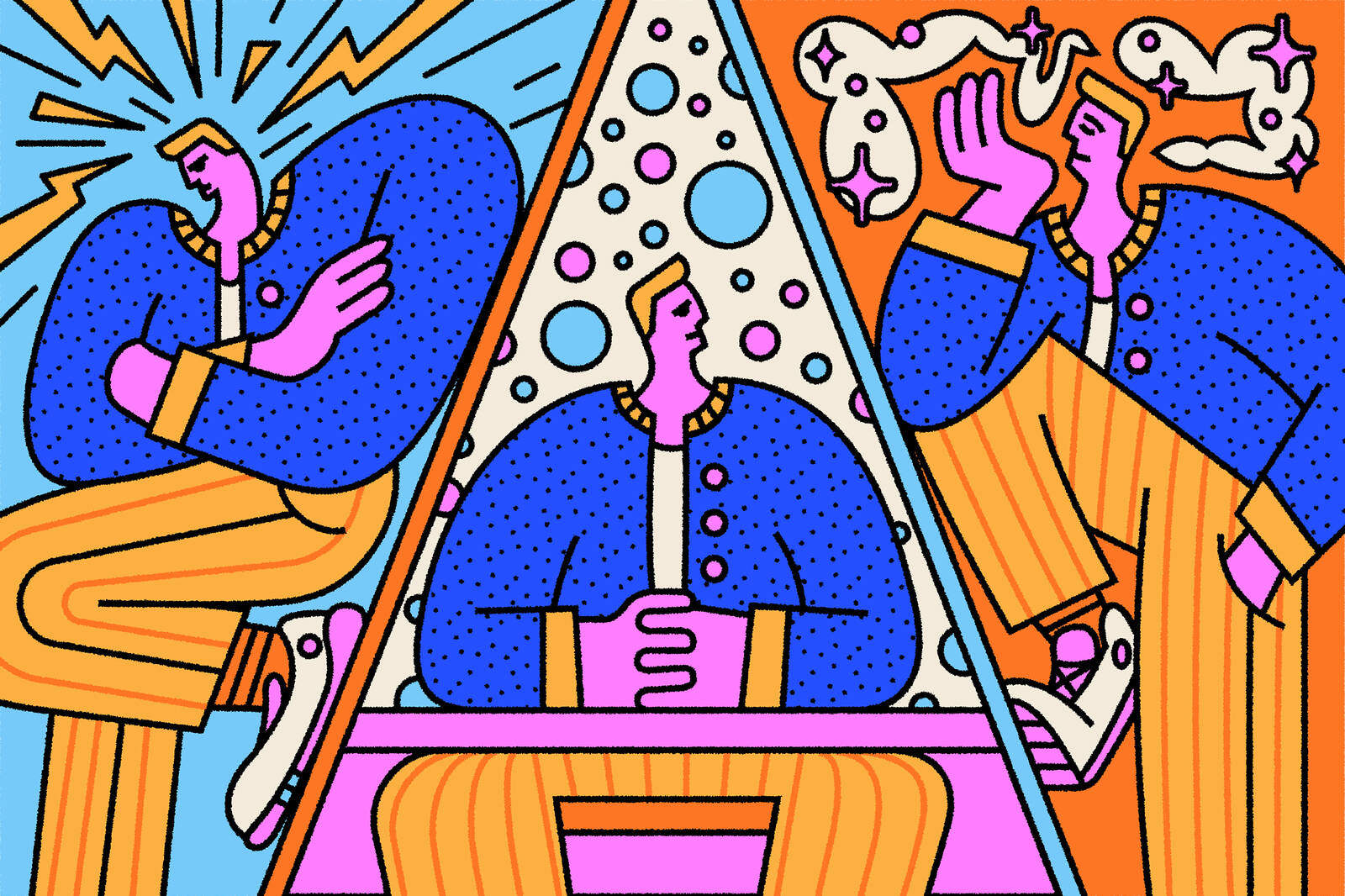Organizations May 1, 2025
Do Gut Feelings Change Over Time?
New research challenges the long-held belief that unconscious attitudes are set in stone.

Riley Mann
For decades, there was a general assumption that our unconscious or automatic thoughts and feelings were unchangeable—a kind of rigid cognitive force.
But that assumption never sat well with Tessa Charlesworth, an assistant professor of management and organizations at Kellogg. It seemed to her that, “even if these are ‘gut feelings,’ they’ve got to come from somewhere—and that somewhere is probably our culture. Then, since our culture is changing, our attitudes and gut feelings should also be changing.”
In a study of more than 1.4 million people across 33 countries, Charlesworth confirmed that people’s automatic feelings about certain topics can indeed change over time—sometimes in tandem with their more outward-facing, controllable feelings, but also sometimes in opposition to them.
She collaborated with Benedek Kurdi at the University of Illinois Urbana-Champaign and Patrick Mair at Harvard University to examine people’s attitudes regarding age, body weight, sexual orientation, race, and skin tone over an 11-year period (from 2009 to 2019). In each of these social categories, they found that people’s explicit attitudes have become less negative toward the non-dominant group. With age, for example, people became less likely to say they prefer the dominant (“young”) versus the non-dominant (“old”) group.
The changes to people’s gut feelings—or implicit attitudes—were more varied, however. They became less negative about sexual orientation (less pro-straight/anti-gay) but more negative about skin tone (more pro–light skin/anti–dark skin), and stayed roughly the same about age, body weight, and race.
On the one hand, “there is an optimistic story to be told here,” Charlesworth says, pointing to the general decrease in explicit bias and the potential for implicit attitudes to change. On the other hand, the discrepancy between explicit and implicit attitudes may serve as a reminder that bias is far from “healed.” There is ongoing bias and polarization of attitudes around the world, perhaps especially among people who hold extremist beliefs (whose attitudes may not have been collected in the current study).
“Both of these things can be true: we can have optimism that the average person across these 33 countries really wants to live in a more-accepting society,” she says, “and we can also acknowledge that discriminatory behavior remains and there are still horrible things being done by extreme communities.”
A positive trend
The study draws from prior research Charlesworth conducted with Mahzarin Banaji at Harvard, in which they found that implicit attitudes about sexual orientation, race, and skin tone had changed dramatically in the U.S. from 2007 to 2020. Bias against homosexuality, for instance, dropped by about 65 percent.
The findings motivated Charlesworth and her colleagues to explore whether these kinds of widespread changes in implicit attitudes were unique to the U.S. or were also occurring in other countries, and how the changes might differ around the world.
To that end, Charlesworth leveraged the responses of more than 1.4 million people from 33 countries from 2009 to 2019 in two types of surveys, one measuring explicit attitudes and the other testing implicit attitudes. Both centered on people’s preferences for a dominant versus non-dominant group in the following categories: sexual orientation (straight versus lesbian/gay), race (white versus Black), skin tone (light-skinned versus dark-skinned), age (young versus old), and body weight (thin versus fat).
“This sea change in explicit bias is telling us that there’s something happening at an international scale to change the norms of what we will say and consciously feel.”
—
Tessa Charlesworth
For explicit attitudes, people self-reported their preferences on a seven-point scale. Those who had a strong preference for the dominant group in a category gave themselves a rating of “7,” whereas those who had a strong preference for the non-dominant group gave themselves a rating of “1.”
At the outset of the study period, people favored the dominant group across the board. But over the course of the 11 years, preferences moved toward neutrality in every category: the average explicit attitude rating across all countries decreased by 43 percent for sexual orientation, 39 percent for race, 28 percent for skin tone, 20 percent for age, and 18 percent for body weight.
In other words, there was a trend toward less overt bias—matching the downward trend seen in the U.S., although generally moving at a slower rate.
“This sea change in explicit bias is telling us that there’s something happening at an international scale to change the norms of what we will say and consciously feel; and internationally, the norms are against the expression of prejudice,” Charlesworth says.
The trend in implicit attitudes, however, was not so consistent.
To gauge people’s implicit attitudes, the researchers relied on the Implicit Association Test, a timed task in which people quickly pair together words and images in a way that, perhaps unbeknowst to them, indicates their unconscious preferences. In the evaluation for age, for example, people had to quickly pair positive or negative words alongside images that represented old or young people.
Across all categories, the only one that saw a substantial decrease in implicit bias was sexual orientation, which fell by 36 percent—a substantial decrease, though just about half the rate of change seen in the U.S. data. Implicit bias hardly moved for some of the other categories—by only 4 percent for race, 7 percent for age, and 8 percent for body weight. There was also an increase of 20 percent for skin-tone bias.
When the researchers mapped out their findings, the contrast was clear. Explicit attitudes decreased almost uniformly, like “one brush stroke, with every category in every country coming down,” says Charlesworth. Implicit attitudes, however, could move in any direction like “a more-complex painting.”
When beliefs (don’t) align
The striking discrepancy between people’s self-reported (explicit) attitudes and their gut feelings (implicit attitudes) reinforces the idea that what people say they believe doesn’t always align with what they may feel under the surface—attitudes that they are either unaware of or unwilling to share.
Explicit attitudes mostly seem to follow societal norms: as the allowance for prejudice fades over time, so too does people’s expression of prejudice against a given category. In contrast, Charlesworth notes, implicit attitudes could come from subtle but repeated exposures to “everyday experiences,” such as media narratives and social discourse surrounding individual categories.
With skin tone, for instance, people’s increasing acceptance of darker versus lighter skin tones aligned with society’s general disapproval of explicit bias. “People were saying, ‘We’re more tolerant; it’s just as fine to be darker skinned as it is to be lighter skinned,’” Charlesworth says. “But it was shocking that, implicitly, those gut feelings were becoming more negative.” In fact, the researchers noticed that much of this increase in unconscious bias occurred after 2015, which is also around the time that rhetoric about fears of a so-called “migrant crisis” started to dominate headlines in most of the 33 countries in this study (especially in Western Europe). It’s often the case that, once these types of underlying beliefs and societal rhetoric take root, they can be hard to change on a meaningful level.
Not just feelings, but beliefs too
And yet, Charlesworth and her colleagues learned that there’s even more nuance to the picture: not only can these kinds of implicit attitudes about race or skin tone change, but implicit stereotypes about them can change as well.
In a separate study published in 2025, Charlesworth, Banaji, Kirsten Morehouse, and Thierry Devos discovered that people’s beliefs and stereotypes about “who is American” have changed significantly over time. They relied on a similar dataset of about 660,000 people, who completed similar kinds of surveys as in the earlier study. They found that the implicit stereotype that “American equals white and Asian equals foreign,” weakened over time, decreasing by 41 percent from 2007 to 2023. The explicit stereotype moved at a similar rate, decreasing by 47 percent.
“People often say that stereotypes have a kernel of truth or that they are even seen as accurate and fact-like,” says Charlesworth, “so it’s a high bar to pass to show that even these stereotypes can change.” The data from this new study shows that “even these stereotypes, or kernel-of-truth beliefs, can change over time.”
Putting in the work
Though the research uncovered clear trends about attitudes among the broader populace, Charlesworth acknowledges that the changes in one region don’t necessarily apply everywhere.
“People in different countries or locations or even offices and workplaces might be experiencing different kinds of prejudices,” she says. For example, whereas unconscious bias about skin tone fell in the U.S., it was uniquely increasing in other countries.
What’s more, the direction in which attitudes change is not fixed. There’s no guarantee that the generally positive trends in recent years will continue. And it’s also not true that things will “inevitably get worse for the next few years, even after a single big event,” Charlesworth says. What will matter are the “everyday, routine actions and social rhetoric that can make a new ecosystem,” which Charlesworth hopes will help maintain the positive trends.
In many ways, it’s up to leaders to champion the behavior they’d like to see. “So often in the business community we believe that unconscious biases are inevitable, ingrained, or unchangeable,” Charlesworth says. “But now we know that that is simply not true. We’ve seen evidence that change is possible—not just in the U.S., but everywhere we’ve looked. And so, as business leaders, we now have to do the work to change them.”
Much of this work entails being thoughtful about how people portray and discuss ideas or topics. Views of body weight, for example, have been shifting with the recent rise of GLP-1 agonists like Ozempic and similar medications, which have spurred conversation about how much weight and obesity is a result of personal choices versus a medical condition. How the media and medical professionals—and the general public—approach the conversation around these drugs is likely going to shape society’s perception of body weight for years to come.
“Change is about shifting the media rhetoric, shifting the subtle exposures, and shifting the structural factors,” Charlesworth says, “It’s about being really aware of your language, the way that you’re associating words together in your company statements. Those are the things that are going to uproot the unconscious bias.”
Abraham Kim is senior research editor of Kellogg Insight.
Kurdi, Benedek, Tessa Charlesworth, and Patrick Mair. 2025. “International Stability and Change in Explicit and Implicit Attitudes: An Investigation Spanning 33 Countries, Five Social Groups, and 11 Years (2009–2019).” Journal of Experimental Psychology: General.
Morehouse, Kirsten, Tessa Charlesworth, Thierry Devos, and Mahzarin Banaji. 2025. “Who Is American? A Comprehensive Analysis of the American = White/Foreign = Asian Stereotype (2007–2023).” Scientific Reports.



